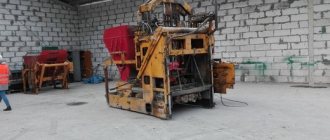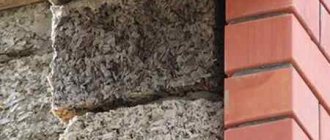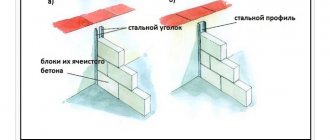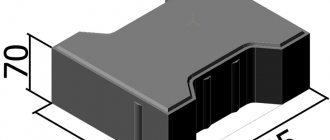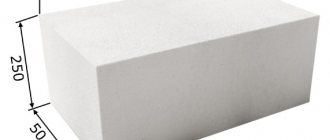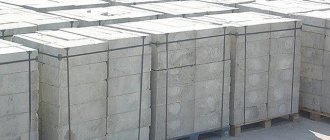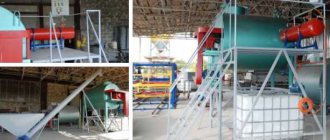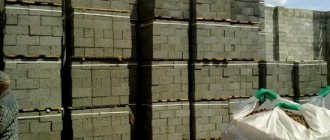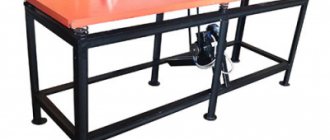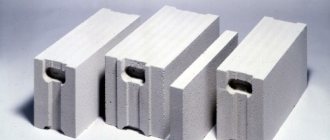What are the options
- Option one allows you to obtain foam blocks of perfectly accurate dimensions. However, it has practically nothing to do with this article, and is only suitable for large-scale production. There, the foam concrete mass is poured into one large mold, and after hardening, it is cut into finished blocks.
2. Tongue-and-groove forms for foam blocks. Allows you to obtain Lego blocks that have certain advantages. Namely, it is easier to lay masonry from such blocks, since they are inserted into each other, which reduces the time for leveling. And the glue consumption is minimal. Such forms for foam blocks are used in production, however, they can also be purchased for private use. Thanks to the high-tech factory production of such forms for foam concrete, even complex tongue-and-groove blocks have a clear configuration.
3. Cassette molds for foam blocks. The most popular option. They are used both in large industries and in private housing construction. Moreover, it is these forms for foam blocks that are most often made by hand.
It is also worth noting that forms for foam blocks can be vertical and horizontal.
And if in powerful industries vertical forms are used on an equal basis with horizontal ones, then for small private volumes the use of horizontal ones is inappropriate.
Vertical forms for foam concrete are more bulky. Walls and internal partitions are more difficult to install and maintain in order, and, as a result, there is a greater likelihood of premature deformation.
And lastly, molds for foam blocks can be solid or collapsible.
To summarize, we note that molds for foam blocks for making with your own hands are horizontal cassette molds. The best option.
Next, let's talk about what foam concrete forms can be made from. What is cheaper, what is of higher quality, what is simpler and what is better.
What you need to have for making
A number of materials and equipment should be prepared when starting production; You can make foam concrete yourself using:
- Concrete mixer. Its volume is determined by the needs of the client. For the implementation of private construction projects, a 300 liter unit is sufficient.
- Medium-fraction river sand, which does not contain any impurities.
- Cement mixture grade M400-M500. It is prohibited to replace it with any other components.
- Steam generator for foam concrete. Production can begin without this equipment, but its presence guarantees increased strength and reliability of the final product.
- Water.
- Containers for pouring the finished mixture. Construction stores offer ready-made forms for foam blocks and gas blocks.
- Foaming agent.
There are other components used in special cases. These include a coloring additive that allows you to create colored material for rooms without finishing. A hardener can also be added to the composition, which increases the resistance of foam concrete to negative temperatures, moisture and other negative factors.
Materials used
Forms for foam concrete must withstand the pressure of the solution, exposure to large amounts of moisture and steam.
Over time, any materials become unusable and need to be replaced. But mainly boards, plywood and metal are used, as well as plastic and foam.
Further about all the materials in a little more detail.
Metal
The most reliable forms for foam blocks are perhaps metal. They are not afraid of high temperatures, rarely warp, and are highly durable. With their help, construction blocks are produced on a serial scale.
Such designs are:
- without reason;
- with a base.
Forms for foam concrete without a base, although cheaper, are less common. The metal in them bends faster, and it is difficult to come up with tightening devices.
Metal molds for foam blocks with a base have many advantages:
- possibility of pouring large blocks;
- high performance;
- long service life;
- clear geometric dimensions of blocks;
- compactness if it is collapsible (disassembled storage does not require much space).
For small batches, you can use used metal formwork, which can last for a long time.
Making a new metal mold is certainly more difficult and expensive than a wooden one.
Laminated plywood
Plywood and OSB sheets are often used in the manufacture of molds for foam blocks in private housing construction. They withstand the pressure of liquid concrete quite well.
The main advantage of the material is its reasonable price-quality ratio, if we are talking about small-scale production of blocks. The service life of the products is 40-50 fills of the solution. With good care they last longer.
Before filling the cells, their internal surfaces are lined with polyethylene or lubricated to prevent the composition from sticking.
It is preferable to use moisture-resistant plywood.
If there is a need to extend the service life, a metal frame can be used when making a mold from moisture-resistant plywood. It will give additional strength to the product. This option is used even in small industries.
Board
It's also possible. When you need it quickly and cheaply.
Wood will not last as long as other materials. But that's not the main thing. It is difficult to achieve perfectly straight sides. And this will already affect the speed of masonry in the future.
You can extend the service life by using polyethylene film, which is wrapped around all surfaces.
Plastic
There are plastic molds for foam blocks on sale. There are even additionally reinforced with metal elements.
They are quite durable and absolutely resistant to moisture.
As a rule, they are designed for one block. Therefore, it makes sense to buy them in small quantities.
And they have a number of advantages. Of which we note the following.
- Possibility of producing a block with a decorative surface. As an option, with additional device. Significantly diversifies the end result.
- Easy to use. They placed it on a flat surface, poured it in, and took out the finished blocks. Separately, it’s not hard. By the way, there are special devices for removing blocks. And there is no need to assemble, disassemble and move heavy structures.
- Convenience. Concrete practically does not stick to plastic, to which slip-improving additives are often added.
There is only one significant drawback of plastic forms for foam concrete - fragility. You have to work carefully.
Styrofoam
This material is indirectly related to our topic.
However, this also happens, so let’s note it.
Foam plastic is used to make permanent formwork for monolithic construction.
Separate technology. Not very common here.
Make foam concrete with your own hands at home - composition, proportions, equipment
Production of foam concrete at home for
Individual construction is advisable in case of a large volume of work.
Then the cost of purchasing equipment will fully pay for itself. But there is still a way
reduce the cost of the manufacturing process more - make equipment for production
DIY foam blocks.
Let us consider these options sequentially, in the form
step-by-step instructions for beginners without experience in construction.
Option 1 – mini production of foam concrete with your own hands using ready-made equipment
For the production of foam blocks at home
an installation is purchased - a specialized set of equipment (machine), and
The foam concrete mixture is prepared independently.
Composition of the foam concrete mixture:
cement (Portland cement, grade M-400 and higher. The cement must be fresh) – 310 kg;
sand (fine-grained or crushed, sifted sand) – 500 kg;
water – 210 l;
foaming composition – 1-2%!о(MISSING)t of cement mass;
modifying additives.
Let's take a special look at the foaming agent. Can be used
ready-made composition, for example, PB-Lux (90 rub/kg) or Foamcem (150 rub/kg) or
make it yourself.
Do-it-yourself foaming agent for foam concrete
Foaming agent composition:
caustic soda (caustic soda) – 0.15 kg; rosin – 1 kg; wood glue – 0.06 kg.
The manufacturing technology is somewhat labor-intensive and takes
a lot of time. Therefore, it is advisable only for significant volumes of work.
How to make a foaming agent for foam concrete at home
Preparation involves two stages:
mixing the adhesive solution. To do this, pieces of dry glue are filled with water (1:10) and left for a day. During this time, the glue will swell a little, but will hold its shape. Therefore, the container with water and glue is heated to 60 ° C (with constant stirring). The adhesive solution is ready when all the pieces have dissolved and formed a homogeneous mass; making rosin soap. For this purpose, the sodium is brought to a boil. Then rosin is gradually introduced into it. The boiling process will take about 2 hours until the rosin is completely dissolved.
Note. Rosin should be crushed first.
Both compositions are mixed when the rosin soap has cooled to 60 ° C.
Note. When mixing, rosin soap is poured into
glue solution Mixing ratio 1:6.
The resulting mixture is poured into a foam generator and foam is obtained
high density. Foam with a density of 80 is considered optimal for use.
g/dm.cub. Using less dense (more airy) foam will reduce quality
block and will lead to its rapid destruction.
Note. You can check the quality of the foam by filling it
bucket. After turning the bucket over, the foam should stay inside.
The production diagram of foam blocks is shown in the figure.
Foam block production diagram
Note that, like the first pancake, the first foam concrete
the blocks usually also come out lumpy. There are several reasons for this:
the difficulty of dosing the constituent components in the solution;
increased/decreased water content in the solution;
increased content of foaming agent in the solution. Its consumption should not exceed 1.5 liters. per 1 m/cub.
Firstly, because the foaming agent is expensive.
Secondly, because its increase in the mixture
increases the time for concrete to harden.
Thirdly, because it will reduce the strength of the block.
varying the kneading time;
experimental determination of time for building strength in blocks;
drying mode of finished (unmolded) blocks.
Unfortunately, such experiments not only prolong
construction time, but lead to additional costs. However, how
Users testify that they are completely justified. Moreover, defective
foam blocks can be used as backfill under the floor, and used
equipment for the production of foam concrete can be sold.
Note. As practice shows, it is better to do
structural foam blocks (grade D-900 and higher). They contain fewer pores
Compared to thermal insulation, they are easier for beginners to make.
Option 2 – making equipment for foam concrete with your own hands
To begin with, let’s note what kind of equipment is generally needed for
production of foam blocks using classical two-stage technology
production.
The factory equipment of a mini-plant for the production of foam concrete includes:
foam generator with compressor for air supply; mixer (in private production a regular concrete mixer is used); molds for foam blocks; additional equipment: pressure gauge, pump.
The complete set of a standard foam concrete installation is shown in
We recommend: How to make a niche for curtains from plasterboard with your own hands
scheme.
Let's look at how to make each of the listed types of equipment at home using improvised materials.
DIY foam generator for foam concrete
Purchasing this module is the most expensive part
production.
Purpose - to convert the foaming agent into foam, before
feeding it into the solution.
The design of the foam generator consists of three components:
feeding module. A foaming agent solution is poured into it. Any container can perform this function; converting module. The quintessence of the installation is foam conversion; dosing module. Provides the ability to supply foam to a solution of a given density (determined by the brand of foam block).
Diagram of a foam generator for the production of foam concrete
Diagram of the device of a foam generator for the production of foam concrete
To make a foam generator you will need: metal
pipe (2 pieces), pump, hoses, valves. And also a welding machine. More
Details of the components are indicated in the specification that accompanies the drawing.
foam generator.
Assembling a foam generator for foam concrete (diagram-drawing)
Drawing of a foam generator for foam concrete
Making a foam generator
The specificity of the factory foam generator tube is that at first
it has a narrow channel, which then widens. This technique allows
increase the speed of passage of the emulsion through the tube. Then the output will be
maximum possible speed.
How to make a foam generator for foam concrete with your own hands?
To do this, you need to make a turbulent mixing chamber and
main foam cartridge.
Making a mixing chamber
Weld two pipes to one of the prepared pipes. Moreover
It is advisable to place one of them (through which air will be supplied) with
end. And weld the second one, intended for supplying the foaming emulsion
from the side (at an angle of 90°).
Both inlet pipes (end and side) are equipped with two
valves:
shut-off (allowing you to shut off the flow of foam concentrate);
adjustable (allowing you to adjust the supply parameters, change the pressure, pressure, quantity, etc.).
In practice, after the feed parameters have been adjusted
mixtures, control valves are not used.
Note. The diameter of the side pipe should be 15-20%!
greater than the diameter of the end pipe.
Making a foam cartridge
A pipe is welded to the second pipe blank. He
designed to release the finished mixture. Outlet pipe is suitable
equip with a device in the form of a funnel to reduce the rate of release of the mixture.
A filter is placed in the blank. The purpose of which is to convert the emulsion into
foam. You can purchase a ready-made filter.
But its function can be performed with no less success
metal mesh (brushes) for cleaning dishes.
At the same time, spiral ones are not suitable, only wire ones. These
the mesh must be compacted as tightly as possible along the entire length of the foam cartridge pipe.
To prevent mesh particles from flying out along with the mixture to the pipe outlet
a “Ruff” is installed, inside of which a mesh washer is installed.
Connection of mixing chamber and foam cartridge
Next you need to connect the mixing chamber and the foam cartridge.
Naturally, this must be done so that the welded pipes are placed with
opposite ends. To ensure an increase in passing speed
foam concrete mixture through a tube, you need to install a Laval nozzle between them or
washer-jet. Replacing the nozzle with a jet will reduce the efficiency of the design by 30-40%!, (MISSING) due to
reducing the speed of passage of the mixture through it. However, it is cheaper and easier to install
and can be used as a temporary option. Installation location of the nozzle or jet
shown in the diagram.
Diagram of a foam generator for foam concrete using a washer jet
Size ratio of foam generator for foam concrete (depth and inlet diameter)
Size ratio of foam generator for foam concrete
Connecting the compressor to the end pipe of the mixing chamber
Any compressor that provides
pressure 6 atm. Using a compressor with a receiver, pressure reducing valve
and a pressure gauge will allow you to regulate the pressure.
Material prepared for the website www.moydomik.net
Connecting the foam concentrate container to the side pipe of the mixing chamber
The container is placed on the floor, a hose is attached to it,
by which the foaming emulsion (foaming agent plus water) will
fed into the mixer by movement through the side pipe. Installation
a small pump (an ordinary household “trickle”) will allow you to organize more
efficient supply of foaming agent to the foam generator. However, in order to save money,
supply can also be organized by gravity.
A foaming agent produced in such a simple way for
foam concrete will cost much less than purchased one. And the resulting foam is nothing
will not be inferior to the foam obtained from the factory generator.
Homemade equipment for the production of foam blocks - video
Setting up a foam generator for foam concrete at home
The second component of foam block production, which can be
to make on your own is a mold for pouring foam concrete.
DIY foam block molds
The molding container can be made from any
materials: plywood, metal, plastic. The main requirement is that the material should not
deform during the process of pouring the solution.
Making a mold involves going through two stages:
calculation of molds for foam concrete; production of molds for foam concrete.
How to correctly calculate the size of the mold for foam blocks?
Building blocks (wall) are usually produced in such
ratio (proportions) length : width : height – 4 : 2 : 1. This ratio
is optimal because it allows you to bandage the rows of masonry without
cutting blocks. Thus, if the depth of the mold is 150 mm, then its width and length
will be equal to 300 and 600 mm respectively.
For private production of foam concrete blocks, it is advisable
use a mold that allows you to simultaneously produce up to 30 foam blocks.
Please note that the length of the form will be longer than the total length
length of blocks. This is due to the fact that the partitions have a certain shape
thickness.
Note. It is better to install partitions in this way,
so that the plane with the largest area is on top. Thus,
ensures faster drying of the block and uniform strength gain
foam concrete. For the same reason, it is not recommended to make multi-level forms.
How to make molds for foam blocks with your own hands?
The process of making a mold begins with the construction of the bottom. TO
the side walls are rigidly attached to it and detachable internal walls are installed
partitions.
Craftsmen advise making a mold for foam concrete blocks
collapsible. This technique will allow you to vary the size of the blocks. For the same reason
The partition plates should not be welded together. It's better to do it in them
cuts up to half the width and connect through them.
If plywood is used as material for
When making formwork, you need to fasten the partitions with nails. Angles, spacers and
etc. will be imprinted on the finished block. It won't harm him, but it won't be beautiful either.
will add.
Advice. It is better to use laminated plywood.
A diagram of the form for foam blocks and the appearance are shown in
drawings.
Scheme-drawing of a mold for foam blocks
Scheme-drawing of a mold for foam blocks (dimensions of formwork elements)
Metal formwork (mold) for the production of foam blocks
Assembling a mold for the production of foam blocks
The advantage of a homemade form is the ability
obtaining foam blocks of non-standard length or configuration.
Note. When making a mold from plywood, before filling
It must be covered with concrete with a durable film. Otherwise, the plywood will pull
moisture from the raw solution, which will lead to deformation of the shape and distortion
characteristics of foam concrete. Using film also simplifies the process
unmolding blocks.
Source: DekorMyHome.ru
| Share on social networks: | Rate this article: (No votes) Loading… |
Self-production
Plastic and foam are out.
We will not consider metal as a material that is not suitable for everyone.
I don’t recommend boards, but if you wish, you can use them in a similar way to plywood. Actually, we will use the latter.
And so, the starting material is moisture-resistant plywood.
Preparation. In an ideal world, we start with a drawing. We indicate all the dimensions, having decided on the dimensions of the future block. Oh yes. Before this, you need to decide on the number of cells. It's not worth much, especially if you have no experience. There are 20 pieces, it will be easier to work. Well, the maximum is 50 pieces.
There is another important point here. If you work on a conveyor belt, while the poured batch hardens, we prepare the solution for the next blocks. I advise you to take this into account when planning how large the future structure will be.
Step by step assembly
- We cut the bottom from a sheet of laminated plywood 8 mm thick. We calculate the size depending on the number of blocks and their dimensions. But that’s not all, don’t forget to cover the thickness of the internal partitions!
- We cut out the sides and internal partitions from the same plywood. We calculate so that the height of the blanks allows the blocks to be cast “flush”. Otherwise, it will be difficult to level the foam concrete mass.
- We make grooves where the partitions will be inserted.
- We assemble the frame, strengthening it from the outside with metal corners.
- We install internal partitions. It is highly advisable to cover them with polyethylene. Be careful and careful to avoid wrinkles and air bubbles.
- In short, that's all. Foam block molds are ready for use.
Light version
If you need molds for foam blocks to build your own home, everything can be simplified.
Do it for one building block. So, it is guaranteed that all blocks will be the same. And it’s easier to make several single-block ones than one large one.
Watch a short video that clearly shows the entire simple design.
And it is very easy to assemble/disassemble.
And, if something goes wrong, the problem will be with one block, not with the party.
Stages of work
If you are interested in how to make foam concrete at home, you need to carefully study the technology for making foam blocks and find the optimal recipe. After this, you can perform the required actions step by step, strictly following the instructions.
Foam concrete technology involves the preparation of cement mortar. It is created in the same way as for traditional concrete. It is recommended to use products under the M400 or M500 brands as a cement mixture.
It is important to make sure that the sand is dry and does not contain unnecessary impurities or additives. To dilute the components, plain water from a centralized water supply system is used.
We invite you to familiarize yourself with the DIY Potato Pit
Foam is added to the finished solution. A foam generator is sold in every hardware store or made from improvised materials.
The next stage is to pour the prepared consistency into prepared forms. Before performing this action, the containers are lubricated with a special solution. Builders know 2 methods of how to make foam blocks with their own hands:
- Molding.
- Cutting.
The first technology involves pouring the solution into the workpieces. When it hardens, you can remove it from the mold and wait another couple of hours for final hardening. Using such a technique has a number of disadvantages. First of all, this is possible damage to the metal, and also deformation of the blocks during removal.
It is quite difficult to install structures with uneven geometry; they are of poor quality and not strong enough. However, the cutting method is more expensive because it requires the purchase of special equipment.
Cutting technology
The production of foam concrete blocks using cutting technology involves dividing the finished slab into several separate sections. Within 6-9 hours, the raw material acquires an optimal degree of strength and can be removed from the formwork. Then the prepared array is moved by a traverse to the cutting equipment, and the specialist begins the cutting process.
The advantage of this technique is the highest accuracy, since the permissible deviation does not exceed 1 mm. The cutting complex is equipped with a special screw for removing the top and twisted strings that cut the material. To obtain different block sizes, the specialist changes the position of the cutting strings. 1 cycle lasts for 5-7 minutes.
After the event is completed, the container with the blocks is placed in a place to dry. After 12-24 hours, depending on the effectiveness of drying, the foam block is removed from the pallet and moved to the storage location.
- The geometry of the blocks is smooth and correct.
- The edges have no deviations.
- Any chips or irregularities are excluded.
The disadvantages include:
- Additional costs for purchasing equipment.
- If the concrete does not harden, it will be destroyed when cutting.
Tips for storage and use
We work with the forms carefully and store them the same way.
The finished building block must have perfectly accurate dimensions. After all, the masonry is carried out on a thin layer of glue. If there are distortions, you will have to either chip off the protruding surfaces or increase the thickness of the glue. In the latter option, this is not only increased consumption, but also an increase in the cold bridge.
And an even block can only be obtained from even shapes. Therefore, it is extremely important not only to accurately assemble them, but also to carefully operate and store them. So as not to inadvertently damage.
Well, the storage tips are banal:
- We carefully place the disassembled forms for foam blocks on racks or pallets (not on the ground!);
- lubricate metal parts to avoid corrosion;
- all parts are covered or covered with film;
- We store it under the roof.
Necessary equipment and materials used
Materials used in the manufacture of foam blocks are primarily:
- Cement
- Sand
- Water
- Pressure setting. This installation is used for mixing the materials used, thanks to the built-in activator. Mixing is done under pressure and therefore we do not need to use a foam generator. When unloading the finished solution, air bubbles increase, which is why our mixture acquires a more cellular and lighter mass. The pressure unit makes it possible to produce foam blocks of different densities, ranging from 500 to 1200 kilograms per cubic meter.
- Vibrating sieve. Used for sifting used materials. Thanks to this process, we will obtain a homogeneous material, which will ultimately have a positive effect on the quality of the manufactured products.
- Compressor. A necessary element when using a pressure setting.
- Form. It is used to fill the produced solution and obtain a certain shape of the foam block.
Price of ready-made (purchased) forms
There are no problems with purchasing molds for foam blocks. The choice is large. Some manufacturers are listed below.
You can purchase ready-made formworks from LEFF Trading House LLC in Omsk, or from Construction Technologies LLC in Kirov, as well as through intermediaries from Russia in Dnepropetrovsk or Chernigov (Ukraine) and in China. Forms, Intek LLC and are in demand. Average prices are shown in the table.
Prices for some samples, for comparison and reference. In general, everything is available if you don’t want to assemble it yourself.
| Name, dimensions (mm) and number of cells | Cost, rub. |
| Plywood container, 600x300x400, 14 pcs. | 9000 |
| Metal, 588x300x188, 24 pcs. | 11 000 |
| Made of steel, 590x360x120, 40 pcs. | 35 400 |
| Made of plastic, 390x190x188, 1 pc. | 300 |
| Polypropylene, 600x300x200, 28 pcs. | 35 000 |
| Metal with polypropylene, 600x300x200, 63 pcs. | 105 000 |
| Without bottom, metal 600x300x200, 22 pcs. | 15 500 |
| With bottom, metal 600x300x200, 35 pcs. | 62 500 |
Products from different manufacturers have similar designs and cost almost the same. The difference in price largely depends on the number of cells to be filled.
Well, self-made molds for foam blocks made of plywood have the right to life. Manufacturers focused on those who build a business on foam blocks also talk about this. Video below.
Manufacturing technology
In principle, making a foam block yourself is not at all difficult if you have the above technological equipment.
The manufacturing process can be divided into several technological processes:
- Preparation (sifting) of materials used.
- Production of cement-sand mortar of foam concrete using a pressure unit.
- Unloading the solution into molds.
The proportions of materials used in the manufacture of the solution for the production of foam blocks must be strictly observed, regardless of whether they are produced on an industrial scale or at home for their own needs.
The density of foam concrete depends on these proportions. To obtain the average density of manufactured blocks, it is necessary to fulfill the following indicators: 1 part sand, 1.5 parts cement + water.
If the production of sand-cement mortar occurs without the use of a pressure unit, it is necessary to add 4 grams of foam concentrate per 1 kilogram of cement.
Making molds for foam block casting
Molds for casting foam blocks can be made in any size suitable for you, it is not necessary to comply with any standards. It is advisable to make molds for casting in such a way that you can pour approximately 40 foam blocks at once. Whatever size cell of the mold you make, this is the size you will get a foam block.
To make a mold, you can use boards, plywood or metal sheets, the main thing is that you can make a box with cells of the size you need for filling. Despite the apparent simplicity of making molds, here, as in every business, there are some points that need to be taken into account. Do not make a multi-layered form, as the lower layers will harden much longer than the upper ones.
Drying of the blocks occurs within two days at a temperature of +50 degrees. Making the mold starts from the bottom. When attaching partitions, do not use corners and spacers. If your form is made of wood, before pouring, the cells of this shape must be covered with film, this will facilitate the process of removing the finished foam block.
